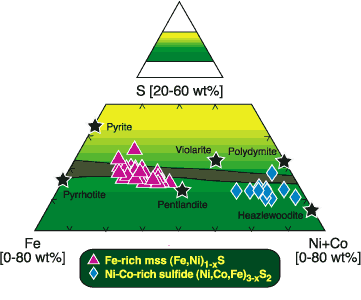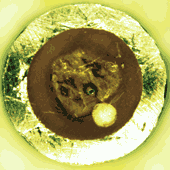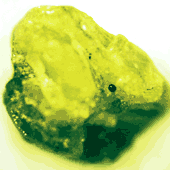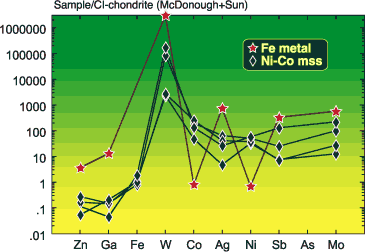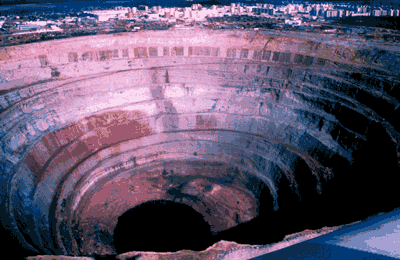 |
 |
 |
 |
Research highlights 2001
GEOCHEMICAL REMOTE SENSING OF THE DEEP EARTH - 4D LITHOSPHERIC MAPPING 2001
Geophysical datasets record the physical properties of Earth's interior
at the present day. Translating this information into actualistic
Earth models requires petrological and geochemical data on real samples
of deep-earth materials. GEMOC has developed a range of tools, collectively
termed 4-D Lithosphere Mapping (eg Publications
1, 234), to study the lithospheric mantle and its evolution, by defining
its composition, architecture and the location of its important discontinuities
(eg crust-mantle and lithosphere-asthenosphere boundaries). This
methodology is based on the integration of geochemical and petrophysical
analyses of mantle-derived materials with tectonic syntheses and geophysical
datasets. It has provided some important constraints on fundamental
questions such as the compositional evolution of sub-continental lithospheric
mantle (SCLM; see Fig. 1, p.20), the lateral
variability of SCLM composition and its effects on tectonics, and the extent
to which lithospheric mantle can be recycled into the convecting mantle,
or is irreversibly differentiated from it. One of the most important
results has been the demonstration that the composition of the SCLM varies
in a systematic way that correlates with the age of the last major tectonothermal
event in the overlying crust (Publications 90, 132,
234; Fig, 1).
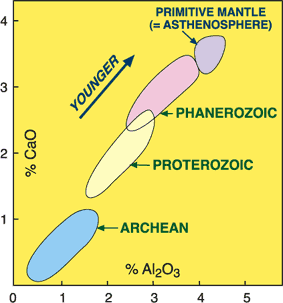 |
Figure 1. Secular evolution in SCLM composition. |
The compositional variations within the SCLM result in differences in
the density and elastic properties of lithospheric mantle of different
age (Publication 228, Fig.
2). Archean and Proterozoic mantle roots are highly buoyant;
they cannot be "delaminated" and recycled. This buoyancy, combined
with the refractory nature and low heat production of Archean SCLM, may
explain the thickness and longevity of Archean lithospheric keels.
However, 4-D Lithosphere Mapping (using mantle fragments sampled by magmas
of different ages in regions such as eastern China) documents the dispersion
of old, buoyant SCLM and the upwelling of fertile asthenospheric mantle,
consistent with detailed tomographic imaging (Publications
64, 234; Fig. 3). Modelling of regional
lithospheric strength (elastic thickness) in the eastern Siberian craton
has shown a N-S lithosphere-scale weak zone within the lithospheric mantle
that suggests lithosphere modification related to deformation (Publication
250; Fig. 4).
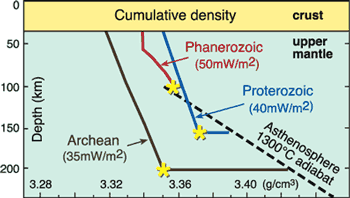 |
Figure 2. Density of SCLM sections as a function of thickness and geotherm, compared to the density of the asthenosphere. Stars show typical SCLM thicknesses. |
Typical Phanerozoic SCLM sections (about 100 km thick) are buoyant under conditions of high geothermal gradient (eg during their formation). However, they are at best neutrally buoyant after cooling to typical stable conductive geotherms; they become vulnerable to Rayleigh-Taylor instability and will tend to delaminate. Asthenospheric material welling up into the resulting "space" will cool to form a new, little-depleted SCLM; this will raise geotherms and may cause crustal melting. As this new SCLM cools, it in turn will become unstable, and start the cycle again. This cyclic delamination may explain the ubiquitous presence of fertile xenolith suites in young basalts erupted through Paleozoic-Mesozoic orogenic belts.f
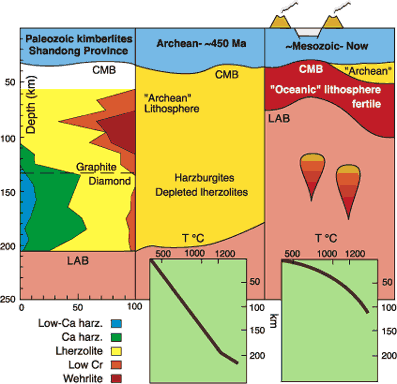 |
Figure 3. Evolution of SCLM under the eastern Sino-Korean Craton, from thick, depleted Archean SCLM in Ordovician time to thin, hot and fertile SCLM now. |
Olivine is the most abundant mineral in all SCLM sections, and the Fe/Mg
ratio of olivine is important in controlling the physical properties of
the lithosphere (density, Vp, Vs). Decreasing Fe/Mg results in lower
density but higher seismic velocity. Because olivine is rarely preserved
(and contains little P or T information), we have inverted a garnet-olivine
Fe-Mg exchange geothermometer to calculate the Fe/Mg of olivine coexisting
with each xenocrystic garnet grain (Publication
222). This inversion has been used to track the compositional
variation of olivine through well-characterised SCLM regions. It
provides an independant confirmation that Archean SCLM is characterised
by much more Mg-rich olivine than Phanerozoic SCLM. In many SCLM
sections worldwide the Fe/Mg of olivine increases with depth (Fig.
5), paralleling an increase in Zr and Ti of garnet with depth.
This pattern probably reflects the transformation (refertilisation) of
SCLM over time by addition of asthenosphere-derived material.
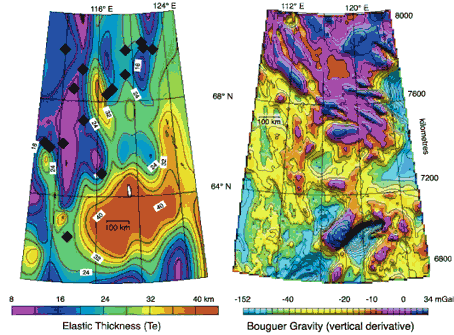 |
Figure 4. Left:Elastic thickness map of the eastern Siberian Craton;kimberlite fields(black diamonds) lie on flanks of weak zones. Right:Bougueranomaly map shows highs overProterozoic areas, lows overArchean areas. |
The contrasting properties of different mantle domains require lateral
contrasts in composition, density, thickness and seismic response in the
present-day SCLM. They also suggest a secular evolution in Earth's
geodynamics from Archean to Proterozoic time, and an increased importance
for lithosphere-delamination processes in Phanerozoic orogens. The
intrinsic buoyancy of Archean SCLM places major constraints on the tectonic
behaviour of old continents; some dynamic models indicate that without
this buoyancy in their cratonic cores, continents would not have survived
on the convecting Earth.
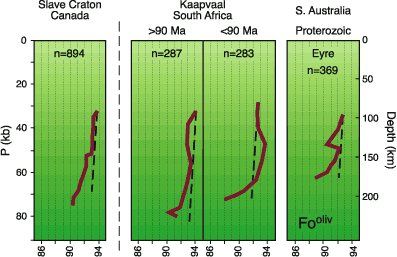 |
Figure 5. Variation of olivine composition with depth in SCLM sections, as mapped from garnet data. |
Contacts: Sue O'Reilly, Bill Griffin
Funded by: GEMOC, ARC, Industry, Macquarie University
MAPPING THE MANTLE WITH GARNET VARIABLES - ORDER FROM COMPLEXITY
Gemoc's database on mantle-derived garnets, built up during 15 years
of work with the diamond exploration industry, long since grew to
over 30,000 analyses. Up to 1995, trace-element data were acquired
with the CSIRO proton microprobe, in collaboration with Dr. Chris Ryan.
Since 1995, we have exploited the greater sensitivity of GEMOC's laser-ablation
ICPMS microprobes to gather data on a wider range of trace elements.
This database has provided fertile ground for collaborating with statisticians
Nick Fisher (formerly CSIRO) and Jerry Friedman (Stanford University).
They have used the large array of variables in the dataset to develop new
ways to recognise populations and anomalies within large data sets, with
an emphasis on techniques that give simple and easily interpreted rules.
The distribution of these populations can then be combined with temperature
(depth) estimates for each grain to map spatial occurrence and thus to
analyse mantle structure.
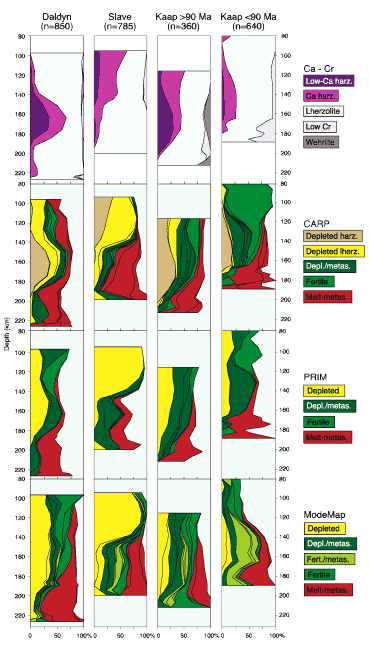 |
Figure 1. Chemical tomography sections for the lithosphere beneath the Siberian craton (Daldyn kimberlite field), Slave Craton and Kaapvaal Craton (in two time slices), showing the distribution with depth of garnet classes defined by classical Ca-Cr relationships (top) and three statistical tools described here, grouped according to their geological interpretation. "metas." = metasomatised. |
Three of these novel statistical approaches (CARP, PRIM and ModeMap) were used to define compositional populations within a database (n >13,000) of Cr-pyrope garnets from the subcontinental lithospheric mantle (SCLM). The variables used are the major oxides, and proton-probe data for Zn, Ga, Sr, Y and Zr. Because the rules defining these populations (classes) are expressed in simple compositional variables, they are easily applied to new samples and other databases. The classes defined by the three methods show strong similarities and cross-correlations, suggesting that they are statistically meaningful.
The geological significance of the classes has been tested by classifying the garnets from 184 mantle-derived peridotite xenoliths, and from a smaller database (n >5000) of garnets analysed by LAM-ICPMS. Several classes reflect different degrees of depletion (melt extraction) of mantle peridotites, others reflect different styles of metasomatism, and several show the metasomatic re-enrichment of formerly depleted rocks. The distribution of these classes with depth has been mapped by measuring the temperature of each grain (from its nickel content) and deriving a depth by reference of the temperature to the local paleogeotherm (Fig. 1).
The relative abundances of these classes in the SCLM vary widely across
different tectonic settings and define intrinsically distinct compositional
mantle domains: some classes are completely absent in either Archean or
Phanerozoic SCLM (Fig. 2). The
distribution of classes can vary widely with depth within individual lithospheric
sections. For instance, the SCLM section for the Daldyn kimberlite
field in Siberia (Fig. 1) shows a thick layer of
strongly depleted harzburgites and lherzolites, overlain by more fertile
lherzolites, and the base of the section has been metasomatised by asthenosphere-derived
silicate melts.
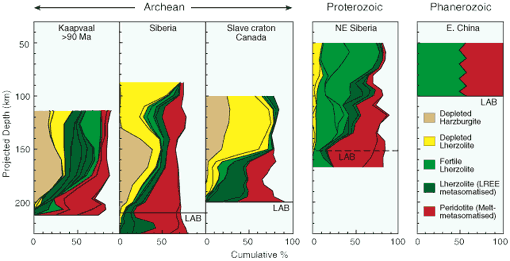 |
Figure 2. Distribution of CARP groups (see Fig. 1) in "typical" Archean, Proterozoic and Phanerozoic SCLM sections. |
Phanerozoic garnet peridotites are uniformly fertile (Fig. 2). Archean SCLM sections generally show high degrees of depletion and varying degrees of metasomatism, and commonly are strongly layered. Proterozoic SCLM sections appear quite different (Fig. 2). Many show a concentration of more depleted material near their base, grading upward into more fertile lherzolites. The distribution of garnet classes reflecting low-T phlogopite-related metasomatism and high-T melt-related metasomatism suggests that some of these Proterozoic SCLM sections actually consist of strongly metasomatised Archean SCLM. If this proves to be true, at least part of the observed secular evolution of SCLM composition (Fig. 1, p.18) probably reflects reworking and refertilisation of SCLM that formed in Archean time, and has survived due to its buoyant and refractory nature.
Contacts: Bill Griffin, Sue O'Reilly
Funded by: DIST, Macquarie University Visiting Fellowship, numerous
industry collaborations and ARC sources
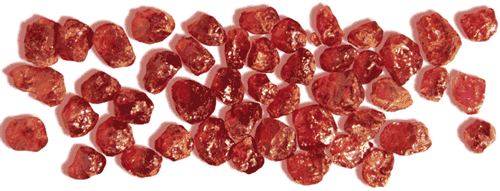
CHEMICAL TOMOGRAPHY BENEATH THE KALAHARI CRATON
Chrome-pyrope garnets brought up from the mantle by kimberlites and
basalts carry large amounts of information on the subcontinental lithospheric
mantle (SCLM). The garnet-classification schemes developed by GEMOC
(see "Mapping the Mantle") now give us a powerful
new tool for mapping the compositional structure of the SCLM, anywhere
that enough volcanic rocks have sampled it.
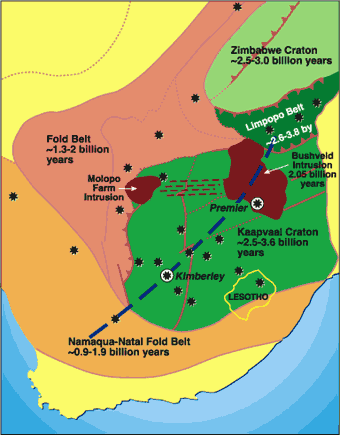 |
Figure 1. Tectonic map of southern Africa(by Lev Natapov) showing locations of sampled kimberlites (stars) and the traverse shown in Fig. 2 (dashed line). |
In 2001, GEMOC mapped the SCLM in space and time, beneath the Kalahari Craton of southern Africa and its surrounding mobile belts (Fig. 1). The project used >3500 garnet xenocrysts from >60 kimberlites intruded over the period 520-80 Ma. Figure 2 shows the distribution of classes defined by the new classification scheme, CARP (developed by Nick Fisher and Jerry Friedman using the large garnet dataset and described on p.20-21), along a NE-SW traverse from the Limpopo Belt through the Kimberley area in the SW, and into the Proterozoic Namaqua-Natal Fold Belt. In order to image mantle composition laterally and vertically, we mapped the distribution of different classes at 150 km depth, along with the mean olivine composition, calculated from the garnet compositions and temperatures (Fig. 3).
The trace-element patterns of many garnets reflect the metasomatic refertilisation
of originally highly depleted harzburgites and lherzolites, and much of
the lateral and vertical heterogeneity in the SCLM observed within the
craton is the product of this metasomatism. The SCLM beneath the
Limpopo Belt is the most depleted section yet studied. It was sampled
by early Paleozoic kimberlites, and the SCLM beneath other parts of the
craton may represent similar material modified by metasomatism during Phanerozoic
time.
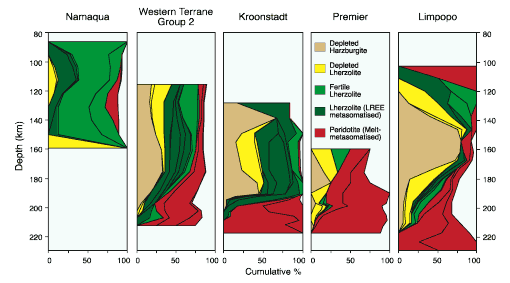 |
Figure 2. Chemical tomography sections for areas along the traverse shown in Fig. 1, showing the distribution with depth of garnet groups defined by CARP. |
The 1200 Ma Premier kimberlite intruded through the massive 2050 Ma
Bushveld complex (Fig. 1). The SCLM under
Premier was strongly metasomatised and refertilised by the Bushveld event,
to produce a much more iron-rich mantle than in the other sections.
In the SW part of the craton, the SCLM sampled by "Group 2" kimberlites
(>110 Ma) is thicker, cooler and less metasomatised than that sampled by
"Group 1" kimberlites (mostly ?95 Ma) in the same area (Fig.
1, p.20). That result affects our use of xenolith data in a wider
perspective - it implies that the extensively studied xenolith suites from
the "Group 1" kimberlites probably are not representative of primary Archean
SCLM compositions.
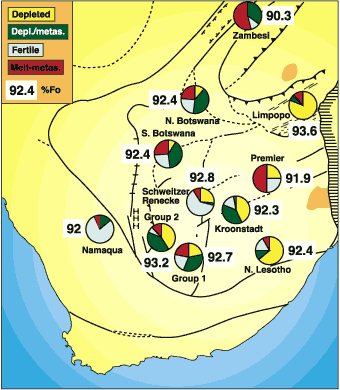 |
Figure 3. Chemical tomography map showing relative abundances of CARP groups in the 140-160 km depth slice, and the mean Fo content of olivine, calculated from the garnet data by the method of Gaul et al. (2000; Publication No. 222). |
The relatively fertile SCLM beneath the mobile belts surrounding the craton is interpreted as largely Archean SCLM, metasomatised and mixed with younger material during Proterozoic rifting and compression. There are strong correlations between mantle composition and the lateral variations in seismic velocity (Vp) shown by detailed tomographic studies (James et al., 2001, G.R.L. 28). Our study showed very small lateral temperature differences within the craton, so the seismic data can be used to map the lateral extent of different types of SCLM. Areas of relatively low Vp within the craton largely reflect the progressive refertilisation (resulting in Fe-enrichment) of the Archean root during episodes of intraplate magmatism, including the Bushveld (2 Ga) and Karroo (ca 180 Ma) events; areas of high Vp map out the distribution of less metasomatised Archean SCLM. The relatively low Vp of the SCLM beneath the mobile belts is consistent with its fertile composition.
Contacts: Bill Griffin, Sue O'Reilly
Funded by: ARC large grant, Macquarie University and Industry
SULFIDES - MORE EVIDENCE FOR PLUMES FROM THE LOWER MANTLE?
Re-os dating of sulfide inclusions in mantle minerals opens new perspectives
on the origin of the mantle (see Research Highlight "Green
and gold - sulfides in olivine date the Siberian lithosphere").
As part of this new research direction, we have recovered a suite of sulfide
inclusions in concentrate minerals (mostly olivine) from the Lac de Gras
kimberlites in the Slave craton, Canada (see Research Highlights 2000 at
www.es.mq.edu.au/GEMOC/). A distinct population of these sulfides,
with a non-stoichiometric structural formula of [(Ni,Co,Fe)3-xS2]
has a high metal/sulfur ratio [(Fe+Co+Ni)/S], unusually high Ni/Fe and
Co, and low Ni/Co relative to the common monosulfide solid solution (mss)
that is more typical of mantle peridotites (Fig. 1).
These Ni-Co sulfides also contain up to several percent of tungsten; this
is unusual because W is not generally compatible in mantle minerals under
common (lithospheric) conditions. These major and trace element systematics
imply an unusual origin for the sulfides from Lac de Gras.
|
"The distinct ultra-high pressure signature of sulfides included in concentrate minerals represents a new tool to recognise sublithospheric influences... " |
Funded by: ARC SPIRT (with Kennecott Canada), Macquarie University and GEMOC
METAL ISOTOPES LEAD THE WAY TO RICHES
Isotope geochemistry is a basic tool for understanding ore-forming processes. Data on variations in the stable isotopes of carbon, oxygen, sulfur and hydrogen have been used to identify the sources of hydrothermal fluids and to model the mechanisms that drive hydrothermal circulation systems. But not all fluids carry metals, and the sources of the fluids and the ore metals could be quite different. Many of the important commodity metals (Cu, Zn, Fe, etc.) have two or more stable isotopes, whose fractionation could carry more direct information on the sources, movements and precipitation of these elements.
Until recently, there have been few reliable data on the isotopic composition
of these metals, because their high ionisation potentials made them very
difficult to measure by conventional thermal ionisation mass spectrometry.
Now the multi-collector ICPMS makes it possible to do high-precision analyses
of the isotopic ratios of Cu, Fe and many other metals. With the
addition of a laser-ablation microprobe, these analyses can be done in
situ, adding information on the spatial context of isotopic variations.
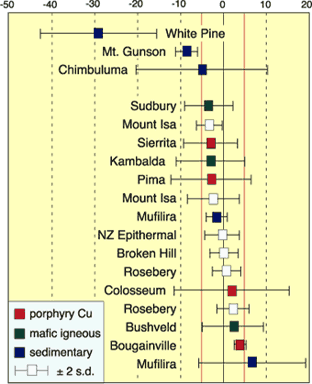 |
Figure 1. Distribution of copper-isotope ratios, expressed as e65Cu, in chalcopyrite from worldwide sources. After Botfield (1999; Honours Thesis, Macquarie Univ.) |
In 1999, Andrew Botfield completed an Honours thesis on Cu isotopes in chalcopyrite from a wide variety of ore samples, that increased the world-wide database by a factor of five and showed that there were large and significant variations in Cu-isotope ratios within and between deposits (Fig. 1).
In 2001 GEMOC, supported by a consortium of five mineral exploration companies, has carried out a study of Cu and Fe isotopes in chalcopyrite, and Fe isotopes in pyrite, from several types of ore deposit. The results show large variations that can be correlated with parameters such as ore grade, temperature, and spatial position within the ore bodies.
The 1640 Ma McArthur River (also known as HYC) deposit is an unmetamorphosed
stratiform Pb-Zn-Ag deposit in northern Australia (Fig.
2). The geological preservation and size of this deposit make
it an ideal location to study the primary geological characteristics of
a Proterozoic sedimentary-hosted Pb-Zn-Ag deposit. Sediment deposition
and mineralisation occurred in a quiet marine environment below the wave
base, as ore-bearing fluids percolated through the basin. Earlier
studies of metal zoning, sulfur isotopes and organic chemistry have defined
a temperature gradient, and suggest that bacterial reduction of sulfate
was an important process in the cooler parts of the ore body, away from
a main vent where the metal-bearing fluids entered the basin.
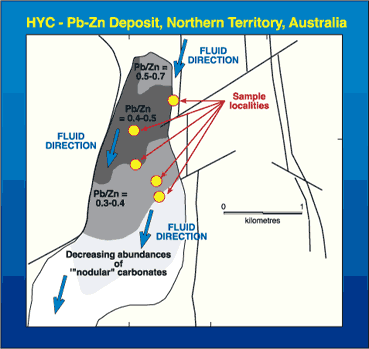 |
Figure 2. Map of the HYC Pb-Zn deposit, showing inferred flow direction of metal-bearing basinal brines, Pb/Zn zoning pattern and the location of samples analysed for Cu and Fe isotopes. |
Chalcopyrite Cu-isotopes (115 analyses) and pyrite Fe-isotopes (140 analyses) were measured over a horizontal distance of approximately 1200 metres through the ore body and reflect changes in the chemistry of the brine as it passed through the basin. Chalcopyrite and pyrite in the hot Cu-rich section of the ore body have isotopically light Cu and Fe. As the brine moved and cooled, it became enriched in the heavy Cu and Fe isotopes (65Cu and 57Fe) as the light isotopes (63Cu and 54Fe) were preferentially removed from the solution by thermochemical sulfate reduction (TSR; Fig. 3). Beyond about 800 metres from the vent, a much greater range in both 65Cu/63Cu and 57Fe/54Fe is observed, and this spread may indicate the beginning of bacterial sulfate reduction. Iron- and copper-reducing bacteria are expected to preferentially remove the light isotopes from solution, with the result that the solution becomes isotopically heavy. The similar proportions of isotopically heavy and light pyrites and chalcopyrites above and below the TSR trend in Figure 3 suggest that up to 50% of the sulfides in this part of the deposit were formed as a direct result of bacterial reduction. This conclusion is supported by palaentological evidence in this region of the deposit.
The use of metal isotopes in ore-genesis studies is in its infancy,
but it shows great promise. In deposits like HYC, the isotopic data
also can be important in mineral exploration - they point toward the source
regions of the ore metals.
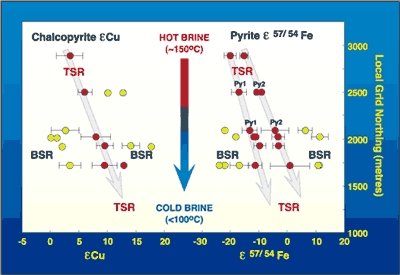 |
Figure 3. Variation in e65Cu and e57Fe in pyrite and chalcopyrite along the HYC ore deposit, showing trends possibly related to temperature (TSR) and scatter that may reflect bacterial sulfate reduction (BSR) in the cooler brines. |
Contacts: Bill Griffin, Simon Jackson, Stuart Graham, Norm Pearson
Funded by: Industry partners, Macquarie University, GEMOC
 |
HOW OLD ARE DIAMONDS?
Diamonds often are described as mantle time capsules - mineral inclusions, once trapped inside a diamond, are protected from the environment, and give us one of our best windows into mantle conditions. But which conditions? When did the diamonds actually crystallise? The most direct way of finding out might be to date the inclusions, assuming that the diamond crystallisation process reset the isotopic clocks in the minerals that became included in the diamond. In the last few years, a lot of time and technology has been spent on determining the Re-Os model ages of sulfide inclusions in diamonds. The results have been used to argue that most diamonds crystallised in Archean time. This approach required rethinking after Slava Spetsius arrived at GEMOC
during 2001 with a collection of large zircon crystals from the Mir kimberlite
in Siberia. These zircons contain inclusions of peridotitic minerals
ˇchromite, olivine, chrome-diopside, phlogopite ˇ that tell us the zircons
grew in the mantle wall-rocks, as part of a metasomatic process.
Some of these zircons also contain inclusions of typical peridotitic sulfides,
with negative-crystal forms (Fig. 2) showing that
they underwent grain boundary adjustment during formation of the surrounding
zircon. In situ LAM-ICPMS U-Pb dating and Hf-isotope analysis
showed that the zircons probably crystallised 355 Ma ago, and in any case
cannot be older than 600 Ma. But in situ Re-Os dating of three
sulfide inclusions gave mean depletion ages of more than 3000 Ma!
It appears that the growth of the zircon did not reset the Os isotope
compositions of the sulfides; the metasomatic fluids probably carried little
Os, while the sulfides contain 50-250 ppm Os.
|
This result implies that the ages of analogous sulfides in diamonds
date the formation of the wall-rock in which the diamond crystallised,
but would only date the formation of the diamond if the sulfide inclusion
and diamond coincidentally formed at the same time. With our current
knowledge and methodologies we cannot unequivocally know when a diamond
itself actually crystallised, and can only know that it is younger than
its sulfide inclusions.
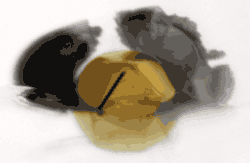 |
Figure 2. 100µm sulfide inclusion in a zircon megacryst from Mir, showing negative-crystal form; the "wings" are expansion cracks lined with sulfide and formed during decompression. The sulfide gives a Re-Os age of 3 Ga. |
Contacts: Bill Griffin, Elena Belousova, Sue O'Reilly
Funded by: Macquarie University visiting Fellow Research Grant,
de Beers Australia, GEMOC
![]()
MICRODIAMONDS AND MICROMINERALS - SLAVE CRATON, CANADA
Mineral inclusions within diamonds represent pristine mantle material
trapped at the time of diamond growth -they have been protected from the
processes that modify the mantle during its tectonic history. Mineral
inclusions in microdiamonds from kimberlites at Lac de Gras in the Slave
Craton, Canada have been studied to investigate unmodified compositions
of the diamond bearing mantle, constrain the proportions of diamond bearing
rock types and provide key information that brings us closer to understanding
the evolution of the Slave Craton in this region.
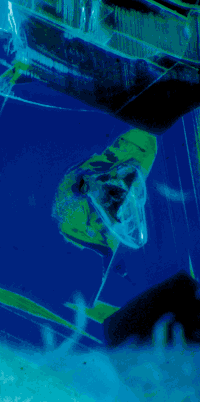 |
Figure 1. Cathodoluminescence image of a diamond, showing internal structure around a mineral inclusion |
Microdiamonds, defined as less than 1 mm in cross section, were selected because they are more abundant and less valuable than macrodiamonds, and are used as indicators to evaluate the prospectivity of a kimberlite body in diamond exploration. Macrodiamonds from one pipe have been studied previously, and we wanted to find out if the two diamond types at Lac de Gras differed. Over two hundred mineral inclusions were extracted from 500 microdiamonds, representing eight kimberlite localities in the central Slave craton, and analysed for major and minor elements.
We found that although some diamond characteristics differ between macro- and microdiamond groups, inclusion compositions and the relative abundances of different paragenetic types of inclusions do not. Microdiamonds from Lac de Gras typically have low nitrogen aggregation states, suggesting that they formed at a late stage in the history of the mantle, possibly just prior to kimberlite emplacement. In contrast, the nitrogen contents and carbon-isotope compositions of micro- and macrodiamonds are similar.
At Lac de Gras a large proportion of microdiamonds contain inclusions from the eclogitic paragenesis (70%), followed by the peridotitic paragenesis (16%); diamonds containing unusual phases derived from the transition zone and lower mantle make up 14% of the microdiamond population. Inclusions in diamonds of lower mantle origin are the oxide ferropericlase, MgSiO3 and CaSiO3-perovskite, SiO2 and Mg2SiO4; the last is likely to have formed as a spinel-structured polymorph of olivine. The lower mantle phases, which occur in combination with one another in single diamonds, suggest a deep origin for these diamonds (~670 km). A small number of diamonds of both eclogitic and peridotitic paragenesis were identified as having possible transition zone origins.
The inclusion data suggest that mantle plumes transported diamonds from the transition zone and lower mantle to the base of the Slave Craton at Lac de Gras. Although lower mantle diamond inclusions typically reflect peridotitic bulk compositions, the abundance of eclogitic diamonds at Lac de Gras, also noted at other localities where transition zone/lower mantle diamonds occur, suggests the presence of eclogites is significant to the processes of mantle formation and dynamics in regions where deep mantle material has been transported to the Earth's surface.
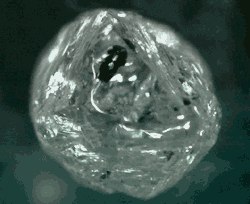
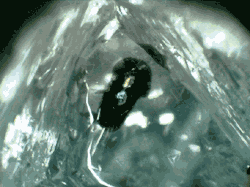 |
Figure 2. Ferropericlase inclusion in a microdiamond from Lac de Gras |
Contacts: Rondi Davies (now at the American Museum of Natural History,
New York), Bill Griffin, Sue O'Reilly
Funded by: ARC SPIRT with Industry Partner Kennecott Canada
GREEN AND GOLD: SULFIDES IN OLIVINE DATE THE SIBERIAN LITHOSPHERE
Gemoc's development of in situ Re-Os analysis of sulfide grains (using the LAM-MC-ICPMS) has provided new insights into the timing of stabilisation and modification of continental roots. As we analyse sulfide populations in more mantle xenoliths, it becomes obvious that most of these rocks have complex histories, with many generations of sulfides and mixtures of Re-Os components, that make whole-rock ages difficult to interpret. The in situ analysis of sulfides in single rocks can sort out this confusion, but it requires painstaking serial sectioning to locate and analyse the small and widely scattered individual sulfide grains.
In 2001, we took a new approach to surveying the age spectrum of a lithospheric
section, by picking sulfide-bearing olivine grains (perhaps 1 in 10,000)
out of concentrates prepared from kimberlites. Dr. Zdislav Spetsius,
mineralogist/petrologist with the Siberian diamond miner Alrosa (Mirny),
scanned many litres of coarse olivine concentrate from the Udachnaya kimberlite.
He arrived at GEMOC with over 100 grains, some containing up to 6 sulfide
inclusions. Over 90 of these inclusions were successfully analysed
for Re-Os and 26 could also be analysed (by LAM-ICPMS) for their contents
of Platinum Group Elements and other trace elements.
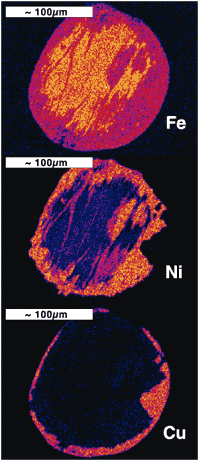 |
Figure 1. Element distribution maps showing exsolution textures in a typical "enclosed" sulfide from Udachnaya. |
The sulfides are mixtures of Ni-rich and Fe-rich monosulfide solid solutions
(MSS), pentlandite and chalcopyrite, exsolved from MSS bulk compositions
(Fig. 1). They can be divided into 5 populations
(1, 2, 3A-3C) on the basis of Os content, Os/Pt and Re/Os.
By comparison with published experimental data, Group 1 sulfides can be
identified as MSS residual after low degrees of melting of a primitive
mantle source, under sulfur-saturated conditions. Group 2 sulfides
are best modelled as mixtures of MSS and alloy phases, formed under sulfur-undersaturated
conditions. The other groups can be modelled as sulfide liquids,
or as the products of reaction between these liquids and the MSS of Groups
1 and 2. Inclusions of different groups may occur within single olivine
grains, suggesting repeated introduction of sulfide melts, followed by
annealing and grain growth.
Sulfides of Groups 1 and 2 give geologically reasonable (0-4 Ga) Os
model ages (TMA). Most Group 3 sulfides contain unsupported
187Os, implying a two-stage history. Our modelling shows
that sulfides with 187Re/188Os <0.07 are unlikely
to have been disturbed. 52 grains satisy this criterion; 45 of these
give TMA ages between 2.5 and 3.6 Ga (Fig.
2). These data suggest that most of the lithospheric mantle beneath
the Daldyn kimberlite field formed during the period 3 - 3.5 Ga, and that
lithosphere formation culminated in a major event at ca 2.9 Ga. There
is little evidence in the Re-Os data for significant further additions
to the lithosphere after this time.
 |
Figure 2. Re-Os model ages of "undisturbed" sulfides from Udachnaya. |
This analysis of sulfides from olivine concentrates gives us a (relatively) rapid way to assess the spectrum of depletion ages in a lithosphere section, and that will be a very valuable guide to interpretation of more detailed work on individual xenoliths. GEMOC has started a program of sampling worldwide, with the help of friends from the diamond exploration industry.
Contacts: Bill Griffin, Norm Pearson, Sue O'Reilly
Funded by: Macquarie University, GEMOC, Industry
ARCHEAN MANTLE HIDING UNDER PROTEROZOIC CRUST IN WESTERN NORWAY
Orogenic peridotite massifs occur in many mountain systems. Most are spinel-bearing peridotites, or their retrograded, hydrated equivalents (chlorite peridotites or serpentinites). Garnet-bearing peridotites are much less common, but many of these rocks bear a remarkable resemblance to some kimberlite-borne mantle xenoliths and they appear to represent slices of lithospheric mantle tectonically emplaced into continental crust during subduction.
Coarse-grained garnet-bearing peridotites have been documented at several
localities in the Western Gneiss Region (WGR) of southwest Norway (Fig.
1). Mantle sequences from the WGR mainly comprise minor garnet-bearing
peridotites (including lherzolites, wehrlites and cpx-free harzburgites)
and dominant, very depleted garnet-free dunites.
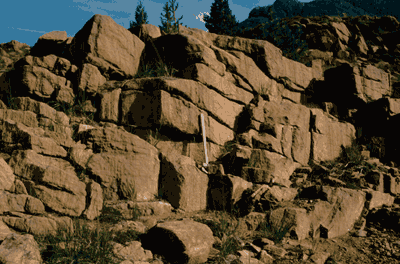 |
Figure 1. Garnet peridotite outcrop at Helgehornsvatn |
The recent development of high-precision in situ laser-ablation techniques enables us to rapidly obtain Re-Os isotopic ages from single sulfide grains in such peridotites. Where the sulfides contain significant amounts of Re, the calculation of Re-Os model ages ("Re-depletion ages" or TRD) requires back-calculation to the likely time of Re addition, to correct for any in-growth of 187Os. In xenoliths, this generally is taken as the time of eruption. In massif peridotites, the correction is less straightforward, and must be based on the age of major magmatic or tectonic events that affected the peridotites.
Two main events may have affected the WGR peridotites. The first
is the Gothian orogeny between 1600-1750 Ma, which saw widespread magmatic
activity and crust-building in Norway. The second is the Caledonian
ultra-high pressure metamorphic event at about 410 Ma, which marks continental
subduction and probably the emplacement of the peridotites into the crust.
The Sveconorwegian (Grenvillian) orogeny at ca 1000 Ma had a limited effect
on the WGR.
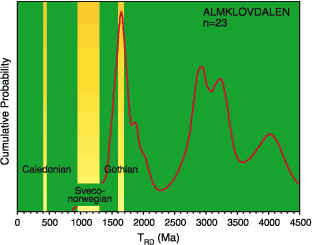 |
Figure 2. Relative-probability plot of TRD model ages calculated assuming Re addition at 1600 Ma. |
Sulfides in the WGR garnet peridotites are predominantly pentlandite ± heazelwoodite and occur both interstitially and as inclusions in silicate phases. Re-Os model ages were measured for twenty-three sulfides from peridotites at Almklovdalen in the southern WGR. On a cumulative probability diagram the TRD ages (calculated at 400 Ma) define several peaks, some of which can be matched to major crust-building events in Norway. There are no obvious Caledonian sulfide ages. Sveconorwegian ages also are poorly represented in the sulfide population, which suggests that this crustal event was not very effective in resetting the ages in the sulfides. Ages greater than 1000 Ma are clearly resolved into distinct Proterozoic and Archean peaks with little overlap. The Proterozoic peak has a maximum at ~1700 Ma which falls within the age range for the Gothian orogeny (1600-1750 Ma) and is close to the calculated Sm-Nd mineral age of 1703 ± 29 Ma for garnet peridotites from the Raudkleivane locality in Almklovdalen.
The greatest surprise, and perhaps the most exciting result of this
study, is the significant number of Archean ages (peaks at 2900 - 3200
Ma). These ages are greater than known crustal ages in the region,
and may suggest that the peridotites reflect a mantle depletion event that
was not associated with crustal growth in this part of the Baltic Shield.
Alternatively, the Archean crust corresponding to this mantle depletion
event may have been reworked in Proterozoic time, to the point of being
unrecognisable. In either case, it appears that mantle material that
underwent depletion (melt extraction) in Archean time has survived in relatively
shallow parts of the lithospheric mantle through a major episode of crustal
generation in Proterozoic time. Its survival is almost certainly
linked to the buoyancy of these highly depleted peridotites, relative to
the underlying asthenosphere. This conclusion has major implications
for our understanding of mantle evolution, and the linkages between crustal
and mantle tectonics.
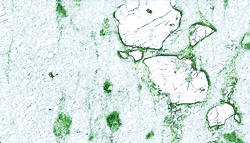 |
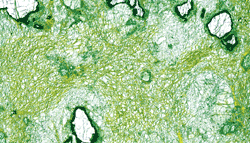 |
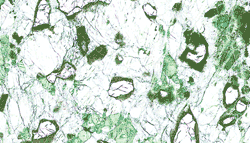 |
Garnet peridotites from the Western Gneiss region, SW Norway.
Contacts: Eloise Beyer, Sue O'Reilly, Bill Griffin
Funded by: ARC, Macquarie University Postgradutae Grant, GEMOC
ANCIENT MANTLE BENEATH NEW ENGLAND
The new england orogen, northern NSW (Fig. 1)
was assembled during a convergent tectonic regime, active along the eastern
margin of the Australian continent in Paleozoic time. It can be divided
into two regions: the Tamworth Belt represents the sediments deposited
at the continental margin inboard of the subduction zone, and the Tablelands
Complex represents a collage of terranes accreted to and dispersed along
the convergent margin. The two regions are separated by the Peel
Fault and the Great Serpentinite Belt, which appear to be relics of the
suture along which oceanic crust was subducted.
 |
Figure 1. Map of the New England Orogen, eastern Australia showing the Tamworth Belt (grey), the Tablelands Complex (blue), the New England batholith (pink) and Tertiary basalts (red) |
Traditional methods of dating surface geology show that tectonic activity in the orogen ceased with the emplacement of the New England Batholith in Carboniferous and Permian time; in the Cretaceous the Tasman Sea was opened, and during Tertiary time abundant basaltic lavas were erupted. The oldest materials recognised thus far are 'exotic' blocks tectonically emplaced close to the Peel Fault. U-Pb dating (plagiogranites and eclogites) and fossils (limestones) give dates that stretch back as far as the Early Cambrian and late Neoproterozoic, but little is known about their affinities or position on the margin of eastern Gondwana.
Mantle xenoliths brought to the surface by erupting basalts represent
samples of the upper mantle and lower crust. Xenoliths from several
locations in the New Engand Orogen have been characterised as part of this
study, and in situ Re-Os dating of sulfide grains found in the peridotites
has been carried out using the GEMOC multi-collector ICPMS laser microprobe.
The Re-Os data can be used to calculate model ages that correspond to periods
of melt extraction from the peridotitic mantle.
 |
Figure 2. Re-Os model ages for sulfides from the New England xenolith localities. Coloured bars are centred on the calculated age, with the length covering the 2-sigma uncertainty. |
Re-Os ages for the xenoliths in this study far exceed the ages determined for the surface rocks (Fig. 2). Xenoliths from Allyn River and Wallabadah Rocks, in the southern end of the Tamworth Belt, give ages in the range 0.8 to 1.8 Ga, and samples from Guyra, in the central part of the Tablelands Complex give ages in the range 0.6 to 1.8 Ga. Model ages for samples from Lawler's Creek, at the north western margin of the Tamworth Belt are significantly older, in the range 1.4 to 3.4 Ga.
These new data show that old mantle can persist beneath younger terrains, probably because of the inherent buoyancy of depleted peridotites (see Research Highlight p.18). The ages also raise questions about the early history of Eastern Australia, prior to the breakup of Gondwana. Why is the mantle beneath the orogen so much older than the rocks at the surface? Is it inherited from a precursor terrane that was broken up and dispersed prior to the onset of subduction along the eastern Gondwana margin? What is the association with other Proterozoic-age blocks now located in Antarctica and elsewhere?
Research is continuing on the subject.
 |
Mt Kaputar, in the northwest of the New England Orogen. Numerous spectacular trachyte plugs remain as evidence of the volcanism here, which took place around 17-20 million years ago, bringing xenoliths to the surface at the nearby Lawler's Creek locality. |
Funded by: Macquarie University postgraduate grant, GEMOC
WANDERING POLES IN THE LATE CAMBRIAN
Palaeomagnetic studies of rocks measure the direction of the magnetic pole at the time a rock crystallised or was deposited. The apparent movement of the magnetic pole between different time periods usually is interpreted in terms of the continental plates moving relative to the pole - but what if the pole itself, and not just the plates, really was wandering?
A palaeomagnetic investigation of Cambro-Ordovician limestones from
Black Mountain in western Queensland is being carried out to assess the
possibility of a large-scale true polar wander event during the Late Cambrian.
Inertial Interchange True Polar Wander (IITWP) is a special case of true
polar wander; it describes the rapid rotation of the solid lithosphere
of up to 90º by the physical crossing, or interchange, of the earth's
intermediate and maximum moments of inertia.
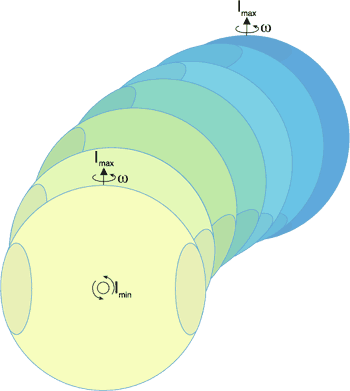 |
Figure 1. Visual representation of IITPW. |
For such a large-scale shift the earth must be modelled as a quasi-rigid spinning spheroid in which a concentration of mass at the poles would produce an inherent instability, leading to the realignment of mass towards the equator (Fig. 1). Palaeomagnetic evidence to support an IITPW event in the Late Cambrian comes from selected groups of palaeopoles from Vendian to earliest Cambrian formations in Laurentia, Baltica, Siberia and Australia. These palaeopoles lie more than 90º away from similarly derived Late Cambrian-Early Ordovician poles.
Ambiguity with respect to the polarity of Early Palaeozoic and older
palaeopoles presents a large degree of uncertainty when we attempt to define
the directions of ancient apparent polar wander paths (APWPs). For
the pole path presented in Figure 2, polarities
of the ancient palaeopoles (>400 Ma) were invoked to minimise the length
of the generated polepath, and IITPW is not supported.
 |
Figure 2. Latest Proterozoic-Earliest Palaeozoic APWP for
Australia. Selected Australian palaeopoles taken from the palaeomagnetic
database maintained by M.R. McElhinny & J. Lock on-line at ....
"http://dragon.ngu.no/Palmag/paleomag.htm" |
However, a shorter path is not necessarily a better path. Before a more detailed APWP can be presented as a part of this study, identification of the age of magnetisations carried by limestones at and around Black Mountain will need to be ascertained. For example, GB1 in Figure 2 is the characteristic palaeomagnetic direction obtained from specimens at Black Mountain. Petrophysical tests will aid in the distinction between an authigenic magnetite, supporting the Silurian remagnetisation age suggested by the presented APWP, and primary remanence, which will support IITPW. If the IITPW hypothesis is sustained by this investigation, it will require a radical restructuring of palaeogeodynamics and the Earth system as we know it.
Contacts: Kari Anderson, Mark Lackie
Funded by: Macquarie University postgraduate grant, GEMOC
STRUCTURE AND CHEMISTRY OF THE AUSTRALIAN LITHOSPHERE
Garnet xenocrysts from a series of localities in southern Australia
have been used to construct a lithospheric transect across one of the major
tectonic boundaries of the Australian continent, the Tasman Line.
The localities, from Jugiong in central NSW to the Eyre Peninsula in South
Australia, cover a range of tectonic environments, from Phanerozoic fold
belt to Proterozoic craton.
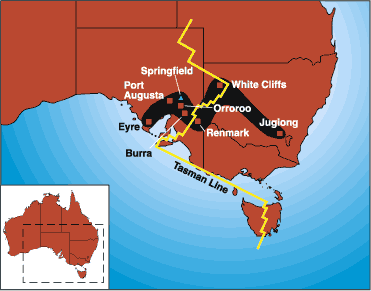 |
Figure 1. Map of southern Australia showing sample localities relative to the Tasman line. |
At each of these localities garnet data have been used to estimate the pressure-temperature regime within the lithosphere and the depth to the lithosphere/asthenosphere boundary (LAB).
These sections reveal thicker lithosphere and lower geothermal gradients
with increasing tectonothermal age of the lithosphere domains. The
paleogeotherm decreases from greater than 50 mW/m2 at Jugiong
to around 40 mW/m2 in South Australia and the depth to the LAB
changes from ca 100 km to 180 km. These physical changes are paralleled
by higher MgO and lower CaO and Al2O3 contents in
progressively older lithospheric mantle, consistent with the global secular
variation in mantle composition (Publications 132,
234).
Comparison of the adjacent Springfield (Permian) and Orroroo (Jurassic)
sections indicates lithosphere thinning by about 10-15 km over this time
period, attributed to the effect of Pangean rifting.
A method of estimating olivine Mg content from garnet composition via an inversion of O'Neill and Wood's (1979) geothermometer has been developed (Publication 222). This method reproduces xenolith olivine compositions in the mantle to within ± 0.5 mol%.
 |
Figure 2. Contour plots of XMgol against depth for sections on the southern Australian transect. |
Application of this inversion to the southern Australian transect shows high XMgol (Mg/(Mg+Fe)) in the shallow parts of the Proterozoic westerly sections and lower XMgol in the Phanerozoic eastern sections, reflecting greater degrees of melt extraction during formation of older lithosphere. There also is an overall trend to lower Mg# with increasing depth in each section, which may reflect infiltration by asthenospheric melts near the LAB. Olivine density varies inversely with Mg#, and the Proterozoic lithosphere in this traverse therefore is more buoyant relative to the asthenosphere than the Phanerozoic sections, despite the lower geotherm beneath the craton. As Vp and Vs also vary with Mg# (the higher the Mg#, the higher the Vp and Vs) these compositional differences are important in the interpretation of seismic tomography.
Contacts: Oliver Gaul, Sue O'Reilly, Bill Griffin
Funded by: GEMOC, ARC APA(I), Industry partners
![]()
HAFNIUM ISOTOPES AND THE BALTIC MARGIN JIGSAW PUZZLE
The integrated analysis of U-Pb ages and Hf-isotope composition in zircon
is proving to be a valuable tool in sorting out tectonic relationships
in complex terrains. A collaborative project between GEMOC and the
Precambrian Geochemistry research group at the University of Oslo, Norway
has used this approach to analyse the relationships between the different
crustal blocks that now make up the Southwest Scandinavian Domain of the
Baltic Shield.
 |
Figure 1. Tectonic map of the Baltic Shield and adjacent parts of the Caledonides, showing the hypothetical suture line through the Permian Oslo Rift in the study area |
Two contrasting tectonic models have dominated the recent debate about this region. In one, the part of south Norway west of the Oslo Rift was an exotic microcontinent, accreted onto the Baltic Shield between 1.58 and 1.50 Ga along a suture, now conveniently masked by the Paleozoic rocks of the Oslo Rift. In the competing model, South Norway has been part of the Baltic Shield since the early Proterozoic, but the crustal terranes building up the area have been displaced southwards along the margin of the Baltic Shield during the Sveconorwegian (i.e. Grenvillian, ca 1000 Ma) orogeny.
LAM-ICPMS U-Pb dating of Mesoproterozoic intrusions from South Norway
in the GEMOC laboratories showed that extensive calcalkaline magmatism
occurred in the period 1500 -1600 Ma, and this magmatism can be traced
on both sides of the Oslo Rift (Fig. 1).
The major and trace element characteristics of the 1500-1600 Ma intrusive
rocks indicate that they formed in a moderately evolved continental margin
volcanic arc setting.
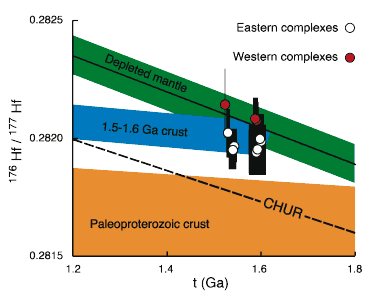 |
Figure 2. U-Pb ages vs Hf isotope composition for S. Norwegian igneous complexes. Calcalkaline rocks of 1500-1600 Ma age occur both east and west of the Oslo rift. The lower 176Hf/177Hf of the eastern complexes indicates a greater contribution of old crustal material during magma generation. |
Zircons from these intrusions show a range of initial Hf isotopic compositions
(Fig. 2). In the western part of the area,
furthest from the Mesoproterozoic continent, the 176Hf/177Hf
values are close to the depleted mantle at the time of intrusion.
In the east, significantly lower values indicate that rising batches of
magma may have interacted directly with Paleoproterozoic continental rocks.
The distribution of Hf-isotope values is consistent with a Cordillieran-type
model for the mid-Proterozoic evolution of the margin of the Baltic Shield.
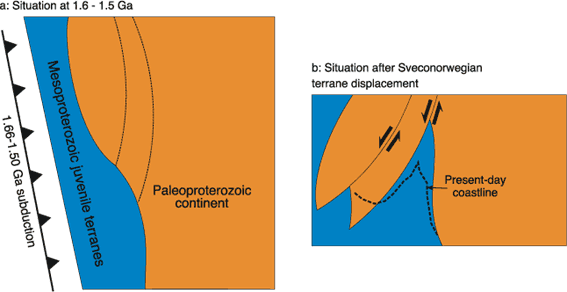 |
Figure 3. Cartoon showing tectonic model implied by the U-Pb and Hf-isotope data. (a) The study area (in blue) was generated at a continental margin, with subduction offshore. (b) Older crust now occurring west of the study area was displaced southward during Sveconorwegian time (ca 1000 Ma). |
Contacts: Tom Andersen (Univ. of Oslo), Bill Griffin
Funded by: GEMOC, Norwegian Research Council
TERRANECHRONTM TAKES OFF
TerraneChronTM is GEMOC's unique approach to terrane evaluation and the study of crustal evolution, based on the integrated in situ analysis of U-Pb age, Hf-isotope composition and trace-element patterns in single zircon grains. The zircons can come from modern drainages sampling a terrane of interest, from ancient sedimentary rocks, or from individual igneous rocks. Using GEMOC's EMP, LAM-ICPMS and LAM-MC-ICPMS facilities (see Technology Development), this methodology gives the age, the host magma type, and the source of the magma (crustal or mantle), for each zircon grain analysed. Applied to zircon suites from ancient or modern sediments, it generates an 'event signature' that defines the evolution of the area in terms of the timing and nature of the magmatic events that have formed its crust (Publications 215, 251, 262).
In 2001, the interest in TerraneChronTM as a tool in mineral exploration, basin analysis and crustal evolution studies took off to an exhilarating extent, with funded projects in Scandinavia, India, South America and Australia. More discussions about collaborative projects are in progress with exploration companies, and state and national geological surveys in Australia and overseas. The advocacy of Dr. Steve Walters from Advantage Geochemical Solutions has been a significant factor in generating this interest. The Geochemical Analysis Unit now reserves one of its laser-probe ICPMS instruments for the U-Pb work, and Ayesha Sayeed recently joined Elena Belousova to add increased capacity for the TerraneChronTM work. The "brand name" is now going through the copyright process, and a series of papers on the results of projects will begin to appear in 2002.
Contact: Bill Griffin, Elena Belousova, Sue O'Reilly
MANTLE MIXUP BENEATH TASMANIA
Mantle xenoliths provide a basic but very powerful tool for investigating
the nature of the lithosphere in space and time. A study of
spinel peridotite xenoliths in Tasmanian basalts has revealed marked heterogeneity
in the lithospheric mantle beneath the northern part of the island.
Tasmania can be broadly divided into two terrains: a Proterozoic terrain
in the west, and a Phanerozoic terrain in the east (Fig.
1). The Proterozoic terrain can be further divided into six regions
or "Crustal Elements" based on geological and geophysical mapping (GSA
Abstracts, 49, 1998). The Phanerozoic terrain is defined as the Northeast
Element. Each of the Elements has a distinct geological history and
internal structure. An east-west traverse across northern Tasmania
sampled xenoliths from the Rocky Cape (RC), Sheffield (SH) and Northeast
(NE) Elements.
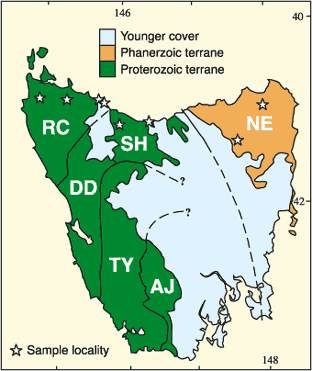 |
Figure 1. "Crustal Elements" of Tasmania (after GSA Abstracts, 49, 1998). |
A correlation between mantle composition and the age of the overlying crust has been observed in numerous terrains around the world and has been interpreted as evidence that crustal volumes and their underlying lithospheric mantle formed at least quasi-contemporaneously, and can remain coupled for periods of eons. In Tasmania it was expected that the mantle xenoliths sampled in the Proterozoic Elements would resemble depleted Proterozoic lithosphere elsewhere in the world, while those erupted through Phanerozoic crust would be more fertile and representative of typical Phanerozoic lithosphere.
However, in Tasmania the majority of mantle peridotites are fertile, even in regions where they have been erupted through Proterozoic crust. In fact, the xenoliths with the most fertile compositions are found in the Rocky Cape Element, which has yielded some of the oldest crustal ages in Tasmania. This suggests that the Proterozoic depleted lithosphere has been either removed and replaced by younger, chemically fertile lithosphere, or refertilised by the infiltration of asthenospheric melts. Rare depleted xenoliths found at some localities may represent remnant Proterozoic lithospheric mantle that has persisted at least to the Tertiary, the time of xenolith entrainment. The seismic velocity of peridotite increases with its degree of depletion (see Research Highlight p.18), and the overall fertile nature of the mantle beneath northern Tasmania is consistent with the relatively low mantle velocities recorded by recent Geoscience Australia seismic surveys.
The presence of unexpectedly fertile lithosphere in northern Tasmania may be related to rifting between Australia and Antarctica during Jurassic time. Crustal extension would thin and disrupt the old depleted lithosphere, providing space for upwelling asthenospheric material that would later cool to form new, little-depleted lithospheric mantle. In this regard, northern Tasmania may be a good model for the generation of young lithospheric mantle beneath many terrains affected by Phanerozoic extensional tectonics.
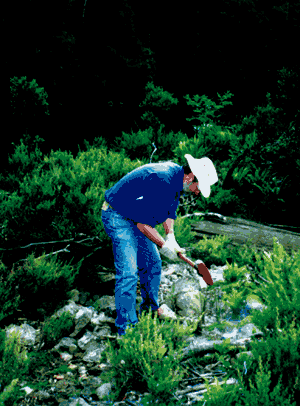
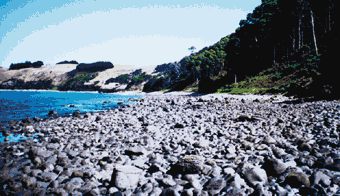 |
Figure 2. Xenolith localities in Tasmania |
Contacts: Eloise Beyer, Sue O'Reilly, Ming Zhang
Funded by: ARC, Macquarie University Postgraduate Grant, GEMOC
PLATEAUS, PLUMES AND FLUIDS IN KERGUELEN XENOLITHS
Oceanic plateaus are vast outpourings of lava on the ocean floor,
and may be good analogues for the development of continents on the early
Earth. The Kerguelen Archipelago (South Indian Ocean) lies on Earth's
second largest oceanic plateau, and is being studied at GEMOC in a joint
research program with an international consortium, headed by the Université
Jean Monnet (St. Etienne). The formation of the plateau is related
to interaction between the South East Indian Ridge (SEIR) and the long-lived
Kerguelen plume, and makes Kerguelen a unique laboratory for studying the
generation of thickened lithospheric mantle in an oceanic setting.
 |
Figure 1. Lac Michèle, on the Loranchet Peninsula (NW Kerguelen). |
Mantle xenoliths provide key information on the geochemistry of the mantle, that can be used to understand the dynamics, physical properties and evolution through time of the lithosphere. On the Kerguelen Islands, mantle xenoliths usually are found in dikes or pipes of young alkaline basalts. However, harzburgite xenoliths recently were found in tholeiitic-transitional basalt dykes at Lac Michèle, on the Loranchet Peninsula (NW Kerguelen, Fig. 1). Their bulk-rock and mineral compositions (e.g Mg# Ol = 90.7-92.2, CaO WR< 1wt %) indicate that these harzburgites are residues from an extensive partial melting event, possibly related to the early formation of the Kerguelen Islands when the plume hit the SEIR 40 Ma ago.
Secondary metasomatic processes that modify the original composition
of the xenoliths are well documented in Kerguelen xenoliths and reflect
metasomatism by alkaline melts and carbonated fluids. Some of the
very depleted harzburgites contain an unusual metasomatic assemblage, composed
of sodium-rich feldspar (Ab78-83An14-19Or2-4),
low Ca-spongy clinopyroxenes, olivine and apatite, that forms reaction
rims on Cr-spinel grains (Fig. 2). To our
knowledge, this is the first description of such Na-rich feldspars in mantle
xenoliths. LAM-ICPMS analyses show that the clinopyroxene is extremely
enriched in the light Rare Earth Elements, Sr ± Th ± U, and
depleted in High Field Strength Elements (Nb, Ta, Zr, Hf, Ti). This
geochemical signature strongly suggests that the metasomatic agent was
a carbonated fluid. The crystallization of this unusual assemblage
probably reflects the percolation of small volumes of volatile and Na-CO2-rich
fluids through the peridotitic matrix, reacting with the peridotite to
crystallise the metasomatic assemblage.
 |
Figure 2. Element distribution maps of a metasomatic "pocket" with Na-feldspar (Fs), clinopyroxene (Cpx), apatite (Ap) and olivine (OlII) in spinel (Sp). |
These observations have important implications for the diversity of geochemical signatures that can be generated in the oceanic mantle above a mantle plume. They show that the percolation of small volumes of fluids can lead to extreme trace element enrichment of previously very depleted oceanic mantle on a very small scale (i.e < mm scale). Further understanding of the processes will require evaluation of the petrogenesis of carbonatitic magmas in an Albite-Calcite (NaAlSi3O8-CaCO3) system.
Contacts: Guillaume Delpech, Sue O'Reilly
Funded by: ARC, Macquarie University, GEMOC
COOKING MANTLE FLUIDS - TRACE ELEMENT MOBILITY
DURING SUBDUCTION
| Subduction of oceanic crust is a crucial step in the generation of
new continental crust, because it promotes magmatic processes in the mantle
wedge above the subduction zone. The generation of these magmas is
linked to water derived from dehydration and/or melting reactions in the
subducted slab. This water is thought to enrich the magma source
region with large ion lithophile elements (LILE), but not with high field
strength (HFSE) or rare earth elements (REE). Early experiments have
confirmed this model on a bulk rock scale for a few trace elements, but
did not discriminate the effects of different mineralogies.
We carried out new experiments on an oceanic tholeiite (MORB) enriched (10-100 ppm) in 25 trace elements; it was crystallized at 3.0 GPa, 650 and 700 ºC for 2 weeks, with 30-50 wt.% added water. One set of experiments used a double capsule configuration, with fluid in the outer sealed Ag-Pd capsule and powdered MORB glass in the unsealed inner Ag-Pd capsule. These produced a clearcut separation of solid and fluid, with growth of some large crystals in the fluid, and the solute could be quenched for study. Experiments in a single sealed Ag-Pd capsule produced a remarkable separation of fluid and solid. The solid component in both capsule configurations showed a distinct mineralogical zoning. At 650 ºC the fluid coexists with omphacite (Figs. 1, 2), lawsonite (Figs. 1, 2), chloritoid (Figs. 2-4), coesite (Figs. 1-3) and accessory phengite (Figs. 1-4), rutile (Fig. 2), Ti-magnetite and talc (Fig. 5). At 700 ºC garnet is conspicuous as a coarse layer at the top (Fig. 6), below which omphacite, coesite, phengite (Fig. 7), minor staurolite (Fig. 8), and rare lawsonite (Fig. 7), rutile (Fig. 8) and talc (Fig. 8) occur; chloritoid is absent. The LAM-ICPMS microprobe lets us examine the trace element contents of individual minerals coexisting with fluid in these experimental charges, and the changes in trace element ratios for the fluid as the coexisting mineralogy changes. LAM-ICPMS spectra also indicate the presence of minute crystals of zircon and allanite, the latter commonly included in garnet or chloritoid crystals. Most importantly the LAM-ICPMS analyses establish patterns of trace element partitioning between minerals (data for omphacite, lawsonite, phengite, chloritoid and garnet) and fluid, if not absolute values. The fluid shows strong enrichment of LILE relative to HFSE and REE. Rb/Sr, Cs/Sr and Ba/Sr decrease from 650 to 700 ºC, apparently controlled by residual lawsonite; an increase in La/Lu is clearly controlled by garnet. Omphacite fractionates both Zr/Nb and La/Lu, so that Zr/Nb decreases and La/Lu increases in the fluid. Rutile strongly takes up Nb and Ta, but cannot explain an almost 4-fold increase in Nb/Ta observed in the fluid relative to the bulk sample. These results indicate that the movement of a fluid derived by dehydration processes may increase LILE/HFSE, LILE/REE and decrease Zr/Nb in the mantle wedge, and thus in magmas derived from the wedge. The fluid may impart different Rb/Sr, Cs/Sr and Ba/Sr to the magmas, depending on the temperature at which dehydration took place. Residual rutile may explain Nb and Ta depletion without significantly affecting Nb/Ta ratios. The observed lack of fractionation in La/Lu restricts the role of garnet in the melting. Thus close examination of key trace element ratios in subduction zone magmas may point to a broad pressure/temperature gradient in the dehydrating slab, giving rise to the fluids that ultimately drove the magma generation. |
"....close examination of key trace element ratios in subduction zone magmas may point to a broad pressure/temperature gradient in the dehydrating slab, giving rise to the fluids that ultimately drove the magma generation." |
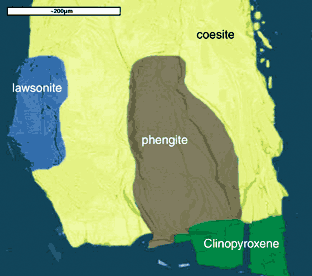 |
Figure 1. Crystal aggregate grown in fluid in outer capsule, 650 ºC. The outer capsule contained 500 ppm Ni and 200 ppm Zn as impurities and these were very selectively taken up by silicate minerals grown in this capsule (eg pyroxene contains 0.6-1.7%, chloritoid 5-6%, phengite 3-4% NiO). No Ni and Zn were evident in the inner capsule, nor in minerals there. |
 |
Figure 2. Large chloritoid (with <0.1% ZnO) in fine grained matrix, inner capsule, 650 ºC. |
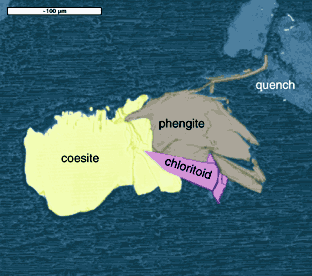 |
Figure 3. Crystal aggregate grown in fluid and quenched solute from fluid in outer capsule, 650 ºC. Chloritoid contains 4% ZnO. |
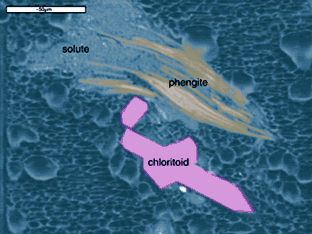 |
Figure 4. As for Fig.3. Chloritoid contains 9-11% ZnO. |
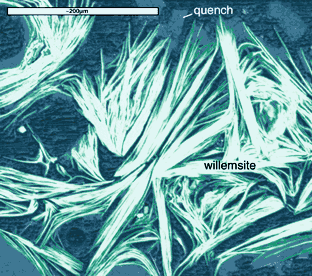 |
Figure 5. Talc aggregate and quench solute from fluid in outer capsule, 650 ºC. N.B. This is actually Ni-talc (willemsite) with Ni coming from the outer capsule (see Fig. 1). |
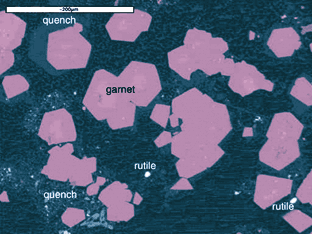 |
Figure 6. Upper zone of sample in inner capsule, 700 ºC. |
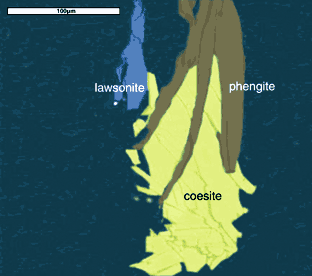 |
Figure 7. Crystal aggregate grown in fluid in outer capsule, 700 ºC. Phengite contains 3% NiO. |
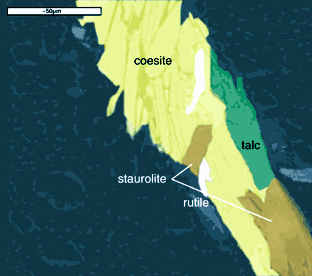 |
Figure 8. Crystal aggregate grown in fluid in outer capsule, 700 ºC. Talc contains 13% NiO, staurolite contains 3-5% ZnO, 3-4% NiO. |
Funded by: Macquarie University Grants
2001 Annual Report
- Contents
- Next
- Previous
- Download a printable .pdf version here (2.2 Mb)
- Research highlights Archive

 GEMOC ARC National Key Centre
GEMOC ARC National Key Centre